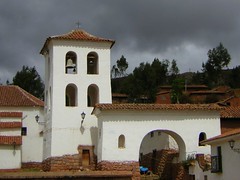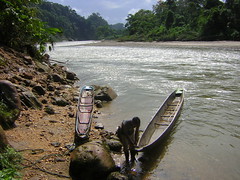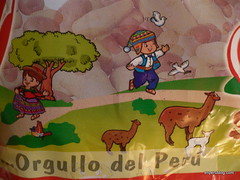US Expat Barbara Drake talks about the win by La Teta Asustada of best film at the Berlin film festival last week and about other notable works covering a dark period of contemporary Peruvian history.
Category: "Modern Peru"
Huaca Huallamarca
In the heart of lush residential San Isidro, the Huaca Huallamarca is one of dozens of pre-Columbian sites found within the city of Lima – a densely populated area even then. Heavily restored and open to tourists, the pyramid sits surrounded by huge modern penthouses that are a stark and unusual contrast for such an ancient ruin.
The last stop – Nostalgia Street
Public transport in Lima used to be orderly, clean, efficient and safe. Bus routes ran across the city in an organised way, drivers and ticket sellers were gentlemanly and vehicles were uniform and spacious. This all changed with the Presidency and quasi-dictatorship of Alberto Fujimori in the 1990s, something that the old-timers of the transport industry lament.
Lima of yesteryear – 1920s to 1970s
The Lima of two periods of time are both equally well known; the colonial and modern Lima that is still visible in the area around the city’s plaza, and the modern noisy metropolis that extends for kilometres.
But what about the time in between?
Bones of a conqueror
The Spanish settlers in Spain, upon their deaths, often wanted to be buried beneath the churches they had built on what they considered foreign and certainly un-Christian land. Doing so they thought was the only way of ensuring themselves a place in heaven. The richest or most important Spaniards in Lima were given prime spots – beneath the alter of the city’s grand cathedral. Here, when work on the church’s foundations was being carried out in 1977, a led box was found proclaiming; “Here is the head of Don Francisco Pizarro, Don Francisco Pizarro who discovered Peru and presented it to the crown of Castile.”
Casa de Osambela-Oquendo
This mansion in the colonial heart of Lima is as beautiful as it is unique. In its 200 year history it has seen two wealthy owners come and go, leaving it with two names. I happened to be passing by when Lizardo Retes, who takes care of the site that is now a cultural centre, offered to show me around – and to the roof where you can see as far as Callao.
Inca Garcilaso de la Vega
Born in Cuzco in 1539, Garcilaso de la Vega was the son of Spanish conqueror Sebastián Garcilaso de la Vega y Vargas and Inca princess Palla Chimpu Ocllo. He grew up in the earliest years of the Spanish empire, just when the conquered Incas were becoming used to Spanish rule. He lived among and was related to indigenous Peruvians who were alive in the days of Huascar’s rule in Cuzco and his subsequent battle with half-brother Atahualpa, as well as those who were alive during the rule of Huayna Capac.
He grew up learning both Quechua and Spanish while living with his mother – until he turned 10. It was then, with the death of his father who had long since abandoned the family, he decided to go to study in Spain with the 4,000 pesos he had received as an inheritance.
Air accident in San Diego reminds us of Alfredo Salazar
In 1937 Alfredo Salazar managed to crash his damaged plane in an unpopulated area of Miraflores.
Just a few days ago a horrible accident occured in San Diego, United States, when a US F-18 fighter jet plummeted into a residential zone, destroying homes and killing four people including two children. The pilot had ejected seconds before.
A similar tragedy almost occured in Peru 71 years ago. A plane completely in flames was heading was falling rapidly over the skies of Lima, heading towards Miraflores – then only a sea-side town found at the end of Av. Arequipa.
The last of the Taushiros
Peru’s Amazon rainforest has seen the last of the great Taushiro nation. Prospering in the area of the Quebrada Aguaruna in Alto Tigre, Loreto, for thousands of years, the Taushiro, like countless other tribes, have been wiped out by us and our world.
Maria Reiche
…Tirelessly, she spent day after day of her life under the hot sun cleaning rocks from lines, and working on her theories as to what they were for. She for one came to the conclusion that the lines were some kind of calendar, marking solstices and the passage of stars and constellations…
Could the Nazcans fly?
It is a mystery as yet unsolved. How were the ancient Nazca able to draw such huge and complicated designs in the barren Nazca plains, drawings so large that they are only visible from the air? Could it be that this pre-Inca civilisation mastered some form of flight allowing them to both create and appreciate their work? Some think so.
Makatampu
The pre-Columbian town of Makatampu stood on the outer edges of the city of Maranga, and as its name suggests, it was a tambo, or resting place, set in the scenery of fields irrigated by two artificial aqueducts. No longer standing – the complex was destroyed in the 1940s to may way for the construction of factories on the old hacienda Conde de las Torres – it was said to have been an important site.








![Barin Bababo: Shipibo Konibo: Cosmovision of an Amazonian People [Featured]](http://farm4.static.flickr.com/3046/2690181371_9560b0c204_m.jpg)
![A Peruvian’s view on the problem of corruption [Featured]](http://farm4.static.flickr.com/3142/2893338595_55ba4bdb3e_m.jpg)
